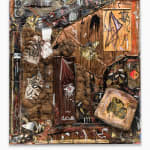Alexandre Diop France, b. 1995
A World without Children will rot, 2021-22
Mixed media on wood, Old furniture parts, fabric, latex, glitter, rubber bands, staples, string, wire, nails, tacks, found metal, leather, pastel, canvas, wood chips, wicker, found paper, oil, and acrylic on wood
78 3/4 x 70 7/8 in
200 x 180 cm
200 x 180 cm
8056
Further images
This work by Alexandre Diop debuted in the group show Surface is Only a Material Vehicle for Spirit at Kavi Gupta in 2021, which was guest curated by sculptor Kennedy...
This work by Alexandre Diop debuted in the group show Surface is Only a Material Vehicle for Spirit at Kavi Gupta in 2021, which was guest curated by sculptor Kennedy Yanko. It is emblematic of Diop's overall practice, which involves the intersection of abstraction, materiality, and symbolic or hidden content. The apparent readability of fragmented images or text within the work juxtaposes with the dreamlike, heavily abstracted visual language Diop employs, challenging the viewer to construct their own relationship to the possible meaning of the work.
Diop is a Franco-Senegalese artist whose process is guided by the physical realities of the materials he employs in his works. Using everyday objects such as books, photographs, metal, and wood, as well as elements like animal hair, fire, and rust, Diop expresses sympathy with the traditions of the Arte Povera movement. Diop describes his approach as occupying a zone between painting, sculpture, and relief. Legibility is one of his main concerns. To be legible, something must make immediate sense, which can be challenging in the context of abstract art. Diop finds legibility not within the metaphysical aspects of his work, or within subjective interpretation of meaning, but rather in the corporal facts embedded within the materials themselves.
He recalls once early in his education making a painting on a wooden door and being frustrated with it, until he pasted a scrap of paper to the surface. The certainty of the paper—what was expressed by its reality without the need for any elaboration from him as an artist—made an impression that forever altered Diop’s understanding of his work. “I saw art as a way to exist,” Diop says, “because I could not seem to exist without saying what I think. I use what appears legible to me, like objects, because I am interested in creating something that’s alive. I want people to feel something. To be impressed. To be shocked. Uncomfortable. Proud. My work creates another reality—not just on a pictorial level, but you feel the reality.”
Diop is a Franco-Senegalese artist whose process is guided by the physical realities of the materials he employs in his works. Using everyday objects such as books, photographs, metal, and wood, as well as elements like animal hair, fire, and rust, Diop expresses sympathy with the traditions of the Arte Povera movement. Diop describes his approach as occupying a zone between painting, sculpture, and relief. Legibility is one of his main concerns. To be legible, something must make immediate sense, which can be challenging in the context of abstract art. Diop finds legibility not within the metaphysical aspects of his work, or within subjective interpretation of meaning, but rather in the corporal facts embedded within the materials themselves.
He recalls once early in his education making a painting on a wooden door and being frustrated with it, until he pasted a scrap of paper to the surface. The certainty of the paper—what was expressed by its reality without the need for any elaboration from him as an artist—made an impression that forever altered Diop’s understanding of his work. “I saw art as a way to exist,” Diop says, “because I could not seem to exist without saying what I think. I use what appears legible to me, like objects, because I am interested in creating something that’s alive. I want people to feel something. To be impressed. To be shocked. Uncomfortable. Proud. My work creates another reality—not just on a pictorial level, but you feel the reality.”
Provenance
Artist StudioKavi Gupta Gallery

